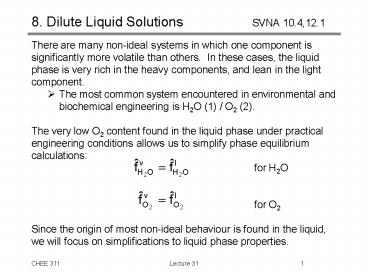8. Dilute Liquid Solutions SVNA 10.4,12.1
1 / 7
Title:
8. Dilute Liquid Solutions SVNA 10.4,12.1
Description:
... of the mixture fugacities of MEK (1) and Toluene (2) at 50 C as a function of ... For component 2, Toluene: CHEE 311. Lecture 31. 3. Dilute Liquid Solution ... –
Number of Views:33
Avg rating:3.0/5.0
Title: 8. Dilute Liquid Solutions SVNA 10.4,12.1
1
8. Dilute Liquid Solutions SVNA 10.4,12.1
- There are many non-ideal systems in which one
component is significantly more volatile than
others. In these cases, the liquid phase is very
rich in the heavy components, and lean in the
light component. - The most common system encountered in
environmental and biochemical engineering is H2O
(1) / O2 (2). - The very low O2 content found in the liquid phase
under practical engineering conditions allows us
to simplify phase equilibrium calculations - for H2O
- for O2
- Since the origin of most non-ideal behaviour is
found in the liquid, we will focus on
simplifications to liquid phase properties.
2
Rigorous Treatment of Liquid Mixture Fugacity
- Shown is a plot of the mixture fugacities of MEK
(1) and Toluene (2) at 50C as a function of
liquid composition - For component 1, MEK
- For component 2, Toluene
3
Dilute Liquid Solution Approximations
- This figure illustrates the fugacity of a
component in a liquid mixture. - Note that the Lewis-Randall rule applies for the
predominant component of a liquid solution - x1?1 ?1 ?1, f1l ? f1l x1
- If the component is present in very small amounts
(x1 lt 0.02), its mixture fugacity can be
approximated by a linear relationship, such that - x1?0 f1l ? k1x1
4
Dilute Solution Simplifications Heavy Component
- For the heavy component (1) of a dilute solution,
we can apply the Lewis-Randall rule - The equilibrium relationship for the heavy
component (such as H2O in the water-oxygen
system) becomes - or,
- or,
- for the predominant component in solution
(x1gt0.98)
5
Dilute Solution Simplifications Light Component
- For the light component (2) of a dilute liquid
solution, we create a new construct, the Henrys
constant, k2 - (12.2)
- This is the slope of the f2l vs x2 curve as x2 ?
0. - The Henrys constant is tabulated for a specific
system at a given temperature. - The equilibrium relationship for the light
component (such as O2 in the water-oxygen system)
becomes - where the Henrys constant, k2 is that of oxygen
in water at the temperature of interest.
6
Dilute Liquid Solution Approximations Example 1
- Suppose we are designing a bioreactor in which
pure O2 is bubbled through an aqueous medium to
replenish the oxygen consumed by the cell
culture. - The process is operated at atmospheric pressure
and a temperature of 25C. - How do we define a thermodynamic system that
provides relevant phase equilibrium data? - What is the concentration of oxygen in the liquid
phase, given a Henrys Coefficient, kO2 4400
MPa at 25C?
7
Dilute Liquid Solution Approximations Example 2
- As a research engineer in a hydrogenation plant,
you are asked to compile VLE data on the H2 /
chlorobenzene system in a way that plant
engineers can readily apply. - The objective is to conduct VLE experiments on
the system, treat the data according to
thermodynamic theory, and summarize the results
in a simple manner. - How will you start?
- What simplifications can be made?
- In what form will you summarize the data?































